June 22, 2007
Beyond Green: Toward a Sustainable Art
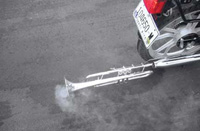
Has "activist" art exited the building for good?
"[...] This evolving hybridization has invited visual art out of the gallery and museum, and into public and unconventional spaces. Most of the art we talk about is not only critical, but also usually situated outside of traditional art venues and often in site-specific circumstances. Does that mean that "activist" art has exited the building for good, leaving only "inactive" works inside? Can socially-engaged, participatory and interventionist art retain its impact within the walls of a museum?
Stephanie Smith, Curator of Contemporary Art at the Smart Museum of Art, has proven that indeed, this work still does have a place in a museum setting. Smith is the curator of Beyond Green: Toward a Sustainable Art, a traveling exhibition of contemporary artists who address sustainability, activism and the future through their work. The exhibition has also been turned into a book by the same name, which showcases the works, essays and artists' statements of the thirteen artists and artists' groups in the show. In her introduction, Smith describes the multiple cultural phenomena and developments in design and art theory that have led to "this holistic, ethical, pragmatic and wildly inventive" artistic practice, and she explores the changing relationship between traditional exhibition spaces and non-traditional art..." From Beyond Green: Toward a Sustainable Art by Sarah Rich, WorldChanging.
Posted by jo at 05:01 PM | Comments (0)
May 24, 2007
New Work on New Climates
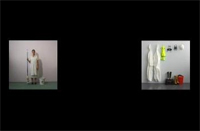
Curated by Shane Brennan
New Work on New Climates: 800 Steps Apart (2007) by Brooke Singer and Brian Rigney Hubbard: 800 Steps Apart questions the response (and responsibility) of government agencies in environmental crises. The administration of toxin-cleanup after 9/11, the video shows, was not uniformly thorough or competent, leaving some victims to suffer the consequences of their contaminated environments. With this terrifying revelation, we are led to question how our government will manage future ecological and environmental disasters that lie on the horizon as a result of climate change. Indeed, 800 Steps Apart challenges the local/global opposition. By uniting a highly localized issue—contamination in Lower Manhattan—and questions of national environmental leadership, the video simultaneously addresses a narrow and broad audience. The way such disasters are handled—even at the level of neighborhoods, blocks and apartments—is relevant to us all; it speaks to our ability and preparedness to deal with environmental emergencies on the global scale—a response that will certainly be tested in decades to come.

Methane (2007) by Michael Alstad: Have we overlooked one of the largest factors in global climate change? Methane is an eye-opening and devastating portrait of the livestock industry as a main producer of greenhouse gas emissions. Our contribution to a destabilizing climate does not stop at the toxins being dispensed into the water and air, but includes the animal products we farm and consume. Alstad emphasizes a circuit between the unnatural living environments of stockyards, ensuing environmental damage, and the Arctic ecosystems that are impacted. Though the footage is shocking, the real cause for alarm—and motivation for immediate action—lies in the causal relationship that is exposed. Why has this link been so often ignored or concealed? What other aspects of the debate have been deliberately left in the dark?
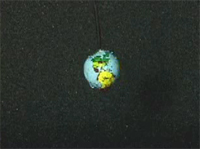
National Agenda (2007) by Gail Wight: National Agenda is part political activism and part Theater of the Absurd. Wight expresses dissatisfaction with our government’s response to global climate change with an intentionally preposterous and violent spectacle. Is this how our political leaders understand (or fail to understand) the changes occurring on our planet—as simply a blunt matter of “things getting hotter”? Coming into harsh contrast with the slick, effects-heavy computer renderings of Earth’s ecological future used in television reports on climate change, National Agenda’s humorous foregrounding of artifice asks us to question the depth of our own understanding of and commitment to the issue. What is the national agenda for climate change?

Rising North (2007) by Jane D. Marsching: As a rendering of scientific data and media reports on climate change in the Arctic, Rising North gestures towards our incapacity to truly absorb and process the magnitude of this information. Rather than recapitulating words or numbers, the video offers emotive fields of experience (both in the visual and auditory spectra) through which we might derive a new, if strikingly incomplete, understanding of “our farthest north.” Rising North, through its ambiguous color modulations and operatic voice that hovers at the limits of intelligibility, may propose that our comprehension of the Arctic is already necessarily partial—it is a region most of us will never encounter first-hand—even as it becomes a heated locus in the climate change discussion. By selecting opera to be the vehicle of conveyance, Marsching also suggests that the Arctic has become a stage upon which the media spectacle of “global warming” is being enacted; we will listen intently to the dramatic tale of its transformation, thawing and steady climb into the frightening upper registers.
And much more >>
Posted by jo at 04:39 PM | Comments (0)
May 12, 2007
Squirrel and Acorn

Cell phone Air Pollution Monitor
" ... Squirrel and the companion software, Acorn, also represent a bold exercise in social responsibility and cross-border engagement. "We want to make air quality data visible, accessible and legible to raise consciousness of environmental monitoring," says Spanhake. For this, she has collaborated with Calit2 researcher Kael Greco, author of a mobile webcam application that uploads images taken by the mobile phone automatically and continuously. These images are tagged and manipulated with the sampled pollution data -- the grittier the image, the more polluted the air is -- then displayed in real time on a web page. "This, along with other visual and audible ways, will help to demystify what 20ppm is in a meaningful way," says Spanhake, adding: "Low-cost technology will also make it available and scalable to the technological, environmental and cultural needs of individuals, communities and cities."
The device is low-cost, mobile, and scalable. It is also intended to be a building block for the creation of a mobile wireless sensor network dependent upon those who breathe the air -- people. "Squirrel is meant to monitor an individual's personal exposure to the air, thus providing a means for agency in the production of air pollution data," says Spanhake. "It will enable supplemental data to the environmental protection agencies that cannot afford to scale their technology to population growth and urban sprawl." ..." From Tracking Pollution and Social Movement: Love Fest for Calit2 Technologies at 'Make Fest 2007'.
Posted by jo at 01:35 PM | Comments (0)
April 04, 2007
Participatory Urbanism
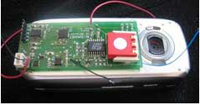
Phone as Environmental Instrument
Last week in Oslo, i attended a very inspiring talk that Tom Igoe gave at the Oslo School of Architecture. He presented open source ideas and explained their impact on the way we think about space.
Among the projects he showed was Participatory Urbanism, a work by Eric Paulos, Ian Smith and RJ Honicky that turns the mobile phone into a “networked mobile personal measurement instrument."
On the one hand, there's a sophisticated device, the mobile phone, which provides us very little insight into the actual conditions of the terrain we traverse with it.
On the other hand is the fact that we must defer to a handful of civic government installed environmental monitoring stations that use extrapolation to derive a single air quality measurement for an entire metropolitan region. Such data doesn't reflect the dynamic variability arising from daily automobile traffic patterns, human activity, and smaller industries.
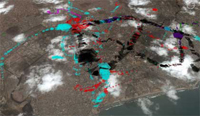 [Left: Carbon Monoxide readings made with taxicabs across Accra, Ghana] The goal of Participatory Urbanism is to provide mobile devices with new “super-senses” by enabling sensing technologies such as noise pollution, air quality, UV levels, water quality, etc. to be easily attached and used by anyone, especially non-experts.
[Left: Carbon Monoxide readings made with taxicabs across Accra, Ghana] The goal of Participatory Urbanism is to provide mobile devices with new “super-senses” by enabling sensing technologies such as noise pollution, air quality, UV levels, water quality, etc. to be easily attached and used by anyone, especially non-experts.
Integrating simple air quality sensors into networked mobile phones promotes everyday citizens to uncover, visualize, and collectively share real-time air quality measurements from their own everyday urban lifestyles. This rich people-driven sensor data leverages community power imbalances, and can increase agency and decision maker understanding of a community's claims, thereby potentially increasing public trust.
Other projects Tom Igoe presented: Public Air Quality Indicator, Area's Immediate Reading and i'll add Neighbourhood Satellites. [blogged by Regine on we-make-money-not-art]
Posted by jo at 03:38 PM | Comments (0)
March 04, 2007
New Climates

Art, Climate Change and Networked Culture
New Climates, curated by Shane Brennan, is an online exhibition of new and existing artworks responding to the relationship between art, global climate change and networked culture. This curatorial weblog will create a flexible and open-ended space to address these ideas at a time when climate change has become a vital concern among artists. Launching in the spring of 2007, New Climates will take the form of a continuously-updated and extensive video weblog.
14 artists have been selected to create short web-videos responding to the pervasive discourse and images of the climate change crisis. The original works may include animations, documentaries, personal testimonials, appropriations, data streams and text or image slideshows. In addition, existing videos and other artworks relating to the theme will be posted and discussed.
As a video weblog—which will be aimed at a broad, heterogeneous audience of art- and non-art-world individuals—the exhibition will be distributed across both space and time: It will be open to the contributions of artists across the globe, and it will grow organically through a series of syndicated (RSS) posts over the course of several months. In this way, the theme of global climate change will intersect with the technology and language of global media. Just as the climate change debate is constantly shifting and evolving, this exhibition will remain transitive, flexible and open-ended.
This project will also explore the contemporary phenomenon of distributed curating: exhibiting artwork across a variety of spaces, networks, temporalities and audiences. It will take advantage of popular technologies (e.g. blogging and web-video sharing) to initiate a dialogue relevant at multiple levels to artists, curator(s) and visitors.
Work will appear in the New Climates exhibition between March and May 2007.
Artists Contributing New Work:
Michael Alstad
Anthony Discenza
Futurefarmers
Jane D. Marsching
Mary Mattingly
Joe Milutis
Cary Peppermint & Christine Nadir
Andrea Polli
Giles Revell & Matt Wiley
Brooke Singer
Jon Thomson & Alison Craighead
Gail Wight
Peter Eramian
Sarah Simon
Artists Contributing Existing Work:
Ben Engebreth
Michael Mandiberg
Posted by jo at 06:00 PM | Comments (0)
January 04, 2007
Transnational Temps
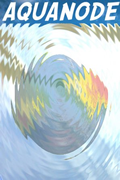
Aquanode 2006
Aquanode 2006 — one of a series of 21st-century Earth Art projects from Transnational Temps was realized in August, 2006, on the coast of western Turkey. Coordinated by Andy Deck, the Aquanode 2006 project used the sunken city of Myndos as a context to explore public attitudes towards the environment. Voice recordings were sealed into buoyant earth globes and released into the Aegean sea in the style of a (digital) message in a bottle.
Transnational Temps was formed by Deck, Fred Adam, and Veronica Perales in 2000. More information about Aquanode can be found on the web at transnationaltemps.net and terranode.org.
Aquanode was accomplished with the assistance of the Istanbul Museum and participants in the Myndos workshops.
Aquanode is also featured in the 2007 Artcontext Calendar!
Posted by jo at 05:48 PM | Comments (0)
December 14, 2006
Environmental Awareness through Eco-visualization

Combining Art and Technology to Promote Sustainability
Abstract: Eco-visualization technology made by media artists offers a new way to dynamically visualize invisible environmental data. Eco-visualization can take many forms. My own practice of eco-visualization involves animating information typically concealed in building monitoring systems, such as kilowatts or gallons of water used. A public display with real time visual feedback promotes awareness of resource consumption and offers a practical alternative to remote meters concealed in utility closets. The long-term goal of most eco-visualization practitioners is to encourage good environmental stewardship using hybrid practices of art and design. This essay contextualizes the emerging field of eco-visualization and its interdisciplinary trajectories. Environmental Awareness through Eco-visualization: Combining Art and Technology to Promote Sustainability by Tiffany Holmes, Neme.org.
Posted by jo at 03:32 PM | Comments (0)
